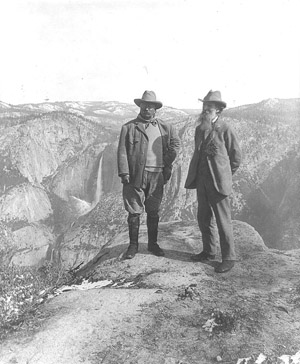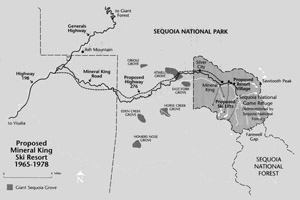The spin-doctors at the right-wing Cato Institute are spinning out of control. In a syndicated editorial (Houston Chronicle, 27 February 2006), these stalwart advocates of the privatization of almost everything in heaven and earth suggest that selling (or giving — they’re not clear on this point) the Grand Canyon National Park to the Walt Disney Company would be good for nature and the public.
The neo-conservative economic theory behind this latest paean to privatization is curious. In their argument, the Cato senior fellows boldly redefine corporations as “simply the economic agents of consumers (us)” and claim that, therefore, environmentalist complaints about corporations’ impacts on nature are “really complaints about the preferences of the rabble.” Trust us, they say. Open public lands to privatization, and “[p]rivate property will end up in the hands of those who value that property most.”
|
WHAT WOULD DISNEY DO WITH
THE GRAND CANYON? In 1966, Disney won a development contract with the Forest Service that would allow the company to build the Mineral King Ski Resort. Sierra Club and other groups waged campaigns against the proposed Disney development. After protracted legal and political battles, environmentalists finally managed to prompt Congress and President Jimmy Carter to stop the Disney plan by annexing Mineral King to Sequoia National Park in 1978.
Disney, however, has succeeded in commodifying the experience of a national park in another way. It launched “Adventures by Disney” family vacation packages last year. Among the adventures offered is a “Quest for the West” weeklong vacation tour of Yellowstone. |
The Cato spin-doctors predict that “those who value that property most” — i.e., the highest bidders for public lands — will best protect the environment, citing a few shining examples of wealthy conservationists: “Market trends also suggest that privatizing public land would move land away from resource extraction and toward preservation and conservation.” But once privatized, the Grand Canyon could become a setting for another theme park, or it could be utilized as the world’s largest landfill; the Rocky Mountain National Park might remain a pristine wilderness or it could be developed as another exclusive ski resort, a “Super-Aspen,” if you will. The rights to possess, use, and convey is what the concept of private property is all about.
But negative thoughts are not allowed. The good ol’ boys at Cato conclude their economic mumbo-jumbo with a free-market mantra: “the public will get what it wants, and what’s so bad about that?”
The Cato argument for the privatization of public lands hinges on the rhetorical device of identifying opponents of privatization, such as environmentalists and those who see our public lands as a sacred national treasure, as eco-elites who do not represent the will of the people. “The demographic profile of the membership of major environmental organizations certainly bears that out,” they say.
 Theodore Roosevelt and John Muir on Glacier Point, Yosemite Valley, California, c. 1906 |
Old Teddy Roosevelt must be spinning in his grave. As an avid outdoorsman, he was alarmed by the destruction of the environment that he witnessed as early as the 1880s, and, as the 26th President of the U.S., he left an impressive conservation legacy to the nation. He established the first bird and game preserves, dedicated the initial 150 National Forests, signed into law the first 5 National Parks and 18 National Monuments, and founded the U.S. Forest Service. All in all, he placed approximately 230,000,000 acres of wilderness in the U.S. under public protection.
Roosevelt’s vision of conservation is still inspirational today:
There can be nothing in the world more beautiful than the Yosemite, the groves of the giant sequoias and redwoods, the Canyon of the Colorado, the Canyon of the Yellowstone, the Three Tetons: and our people should see to it that they are preserved for their children and their children’s children forever, with their majestic beauty all unmarred.
TR’s conservationist vision, embraced by the nation at large throughout the 20th century, is incompatible with privatization of the remaining open spaces and the inevitable development that will accompany it. Capitalism in the U.S., under the imperative of continuous accumulation and expansion and promoted by right-wing think tanks such as the Cato Institute, is on a collision course with the environment.
Only by seeing through the spin and understanding the forces behind the current attack on public ownership can we hope to confront it. Time is short — there’s not much of the majestic beauty left unmarred.
Richard D. Vogel is an independent socialist writer. He has recently completed a book, Stolen Birthright: The U.S. Conquest and Exploitation of the Mexican People.

